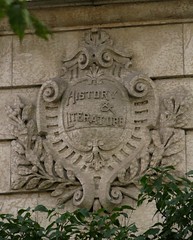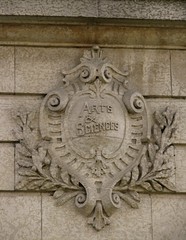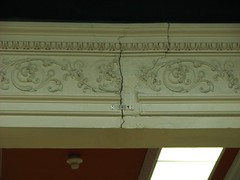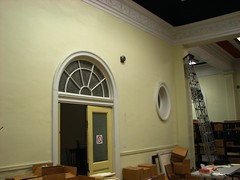Address: 380 William Avenue
Opened: October 11, 1905
Contractor: Smith and Sharpe
In its earliest decades, the city of Winnipeg spent so much time and money meeting the basic infrastructure needs for its quickly growing population that services such as parks and libraries were forgotten about. In fact, it was 31 years after its incorporation that the first Winnipeg Public Library branch opened and it had little to do with any civic politician.
For most Winnipeggers, the ability to borrow or browse a book was very limited prior to 1905. Libraries were confined to schools and universities and the reading rooms at institutions such as the Manitoba Club were for members only.
The closet thing to a public library was the Historical and Scientific Society of Manitoba, (forerunner to the Manitoba Historical Society), collection of thousands of volumes of mostly academic books, journals, and magazines located in a cramped room at city hall that could be browsed or borrowed.
It was John Palmerston Robertson, Manitoba's provincial librarian, who found the funding for Winnipeg's first public library.
Robertson was born in Scotland and raised in Ottawa. He attended law school but left to become a journalist instead, eventually becoming the general editor of the Ottawa Times.
In 1879, Robertson came to Winnipeg to continue in his profession. He worked for the Times and Free Press and did some freelance magazine writing. Five years later, he was approached to see if he would take on the task or organizing the province's growing collection of books, maps and other documents into a formal library and archives. He accepted and was appointed Manitoba's first provincial librarian, a position he held from 1884 until his death in 1919.
Robertson had a growing concern that the city of Winnipeg had still not yet established a public library and took matters into his own hands by contacting Andrew Carnegie's office in New York. The Scottish-American industrialist was giving out millions of dollars in grants to cities and towns around the world to build libraries, including $100,000 in 1900 for one in Robertson's home town of Ottawa. (In the end, there are more than 2,500 Carnegie-funded libraries - about 125 of them in Canada.)
Robertson asked if Winnipeg could make the same arrangements with Carnegie as Ottawa had for its library and he received a positive response.
On July 22, 1901, Robertson informed city council that Carnegie agreed to fund up to $100,000 for a library if the city agreed to provide the land on which it could be built and at least $7,500 per year for its operations.
Council held a special meeting four days later to unanimously pass a motion to accept the grant and requesting the city's legal department to sign a formal agreement. (The grant total was finalized at $75,000.)
Interestingly, not everyone was completely behind the library funding.
Mayor Arbuthnot, for reasons not fully explained in the papers, at one point suggested that the matter of the library grant should be put to ratepayers in a referendum to see if a library was something citizens actually wanted. He also called a special meeting in July 1903 where it was rumoured he would veto the library plans submitted by the architect. He denied the rumours and in the end there was no veto.
There were many in the labour community who also wanted the city to have nothing to do with Carnegie's money due to his union-busting activities that sometimes ended in bloody and even deadly demonstrations.
At the annual meeting of the Trades and Labour council in September 1905, a month before the new library opened, one delegate said that "It was built with blood money - money earned by the wholesale murder of working people."
It
took many months decide on a site for the library.
Many
potential locations were discussed and in August 1903 the William Avenue at
Dagmar Street site was agreed to. Its close proximity to city hall was one of its main attributes. There was an attempt to expand the site but none of the neighbouring property owners were
willing to sell to the city at a reasonable price.
The city launched a design competition for the new building. It was awarded to Hooper and Walker, (this was before Samuel Hooper became the provincial architect)
Construction began on the Carnegie Library in late 1903 and was completed in August 1905.
It was then turned over to subcontractors Winnipeg Paint and Glass to build and install the bookcases, and the John Hart Company which had the contract to acquire the new books for the library. Many of the books and magazines from the old reading room at city hall were also transferred to the new building.
The building's main floor had separate men's and women's reading rooms and a new book area. It also contained the librarian's office and a boardroom. The check-out counter was located in the centre of the main floor across from the entrance so that you could, "...enter, set your book and leave the building without disturbing or passing through any room where people are in the act of reading, referring or studying." (Winnipeg Free Press, Oct 11, 1905).
The basement held a newspaper reading room, book repair facilities, and storage areas. The top floor contained the stacks, a children's area, and a lecture hall.
At 2:30 p.m. on Wednesday, October 11, 1905, Governor General Earl Grey and his nineteen-year-old daughter Lady Evelyn opened the library.
Children from Norquay, Alexandra and Machray schools lined the walkway up to the front door creating an "honour guard" for guests to walk through. Lady Evelyn, (who would become the Canadian pairs figure skating champion in 1911 and 1912), turned the key to open the new building.
Once inside, there was a tour, music and short program of speeches.
Earl Grey was issued the very first City of Winnipeg library card and a book was checked out to him - a leather bound copy of George Bryce's A Remarkable History of the Hudson's Bay Co. (which, of course, did not have to be returned!)
Alderman Sanderson said at the event, "I sincerely trust that the institution, which is being opened under such auspicious circumstances, may realize the fullest expectations of Mr. Carnegie, and at the same time prove a boon to the citizens of Winnipeg." (Winnipeg Free Press, Oct 11, 1905).
Reading the coverage of the opening ceremony in all three daily papers, it is unclear if Robertson was even in attendance at the event. While civic politicians publicly patted themselves on the back and heaped praise on Mr. Carnegie in New York, there was no mention of Robertson's role in the speeches.
The fate of the building was uncertain but the following year, after community protest, a small branch library was opened on a portion of the the main floor. The remainder of the building became home to the city's Archives and Records Control department.
When the branch library closed in 1994, the archives took over the entire building.
The ageing building was not very suitable for archives and records control as there were no modern heat or humidity controls. Roof leaks and cracking plaster meant that documents needed to be covered in tarps to protect them from permanent damage.
A number of facility upgrades began in 2009, including waterproofing the foundation and masonry repair. This will be followed by the addition of an access ramp and the replacement of the wrought iron fence on the grounds.
The city is currently working on a Facility Renewal and Redevelopment Strategy for the building to ensure it's survival and the safety of the materials stored there.
UPDATE 2023:
In the summer of 2013, the building was undergoing more extensive renovations when a heavy rainstorm flooded caused extensive damage. At the time, the city's Archives and Records Control department was being housed in a temporary site on Myrtle Street awaiting the completion of the multi-year renovations.
A long legal battle between the city and contractor began and left the future of the building in limbo. Over the years, several proposals have been made, including scrapping this building and moving the archives to another location, or even to construct a purpose-built facility for the archives, but none of the proposals got traction at city hall.
In 2018, the National Trust for Canada declared the Carnegie Library Building one of Canada's most endangered historic structures.
In 2021, the city approved in principal a proposal to continue renovations on the building so that the city archives could return. The nearly $13 million was approved in the 2023 budget and, if the city follows through on its commitment, the renovations could be completed by the end of 2024.
Related:
380 William Avenue Historic Buildings Committee Report (1984)
380 William Avenue HistoricPlaces.ca
Archives and Records Control Homepage City of Winnipeg
A New Home for the City of Winnipeg Archives blog













You've been a true advocate for this building, something which has been all too rare over the years. I'm glad to see that the Carnegie Library is getting a badly needed overhaul - I just hope that it goes beyond the bare minimum to keep the walls from collapsing.
ReplyDeleteJust a small correction -- J.P. Robertson was the provincial librarian, not the city librarian. The public library in the city hall was run by Henrietta Jackson with an assistant. The Carnegie grant was a form of blackmail to induce cities and towns to establish and run good public libraries. The grant covered only the building -- cities getting grants had to guarantee that they would provide up-to-date collections, an ongoing budget, and adequate paid staff.
ReplyDeleteWhen I was a kid circa 1955-1960 my father was the janitor on the 4pm to midnight shift. On Fridays, when the library closed early my mother and I would walk to the library from our home about ten minutes away and bring him his supper. My mother would help mop floors so he could come home an hour or so early.
After dark, being children of the Depression, my parents would turn off the lights in any room they had finished cleaning. They considerately left me a pool of light nearby where I could play with toys or read picture books. On the second floor I came under the watchful eye of the Andrew Carnegie portrait that now hangs in the Mellennium Library. The eyes followed me whereever I moved and between Carnegie and the darkness I had an effective chaperone.
Later, in 1968-9 I worked as a Library Assistant on the reference desks before going to library school in Edmonton. After it was taken over by the City of Winnipeg Archives I spent some time there doing research. Lots of memories of this building.
It's great to find this information. I worked as a Library Assistant in the building for one year 1970 to 1971, but I lived there for many years before as a very bookish child. I remember the coke machines on the mezzanine floor - a nice touch. Harry Easton was the Librarian at the time.
ReplyDelete